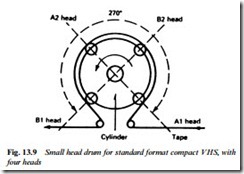SMALL HEAD DRUMS
In order to produce very compact VCRs and camcorders, ways were found to record standard Video 8 and VHS track-patterns on tape by means of smaller than standard head drums.
A small-drum configuration is shown in Fig. 13.9. This is designed for the VHS system, and is suitable for recording and playback. It is used in portable equipment, often with a miniature cassette (VHS-C) containing a small (30 mins) reel of standard VHS tape: the mini- cassette fits into an adaptor of the shape and size of a standard cassette package for replay in a full-size machine. Some camcorders use the small-drum system with a full-size cassette.
The mini-VHS head drum is two-thirds the diameter of a conventional VHS head drum (41.3 mm and 62 mm respectively). The essential requirement is to record standard track patterns, for which the tape must be wrapped around three-quarters of the drum’s circumference, i.e. 270°. Four heads with suitable azimuth offset are mounted at 90° angles around the drum, which itself rotates at 1.5 times normal speed: 2250 r.p.m. Both tape and drum rotate anticlockwise.
Consider head A1 in Fig. 13.9. It is timed to enter onto the tape just as a field scan is finishing, and starts by recording the new field sync pulse on tape. At the end of the field, head A1 is running off the tape at the end of its 270° sweep, and head B2 is entering the tape wrap to record the next field. This is completed by head B2 270° and 20 ms later; as it leaves the tape wrap, head A2 is just entering
the tape 90° further round to record TV field 3. Heads A2 and A1 have the same level and azimuth, and record identical tracks. Completion of head A2’s sweep of the tape puts head B1 (identical to B2) at the starting point of the tape wrap to record field 4, at whose termination A1 takes over once more to repeat the head-sequencing cycle.
Thus by a four-field sequence of head-switching, standard VHS signal patterns can be laid into the tape; during replay the same switching sequence enables continuous replay of a standard VHS recording. The head-switching waveforms are derived from a drum tacho-pulse, and apart from the necessity for four replay head- preamplifiers the rest of the electronic circuits are similar to those of conventional machines.
In Video 8 technology, very tiny camcorders – palmcorders – are made possible by reducing the diameter of the (already comparatively small) head drum. The same techniques of long wrap and multi- head switching are used.
